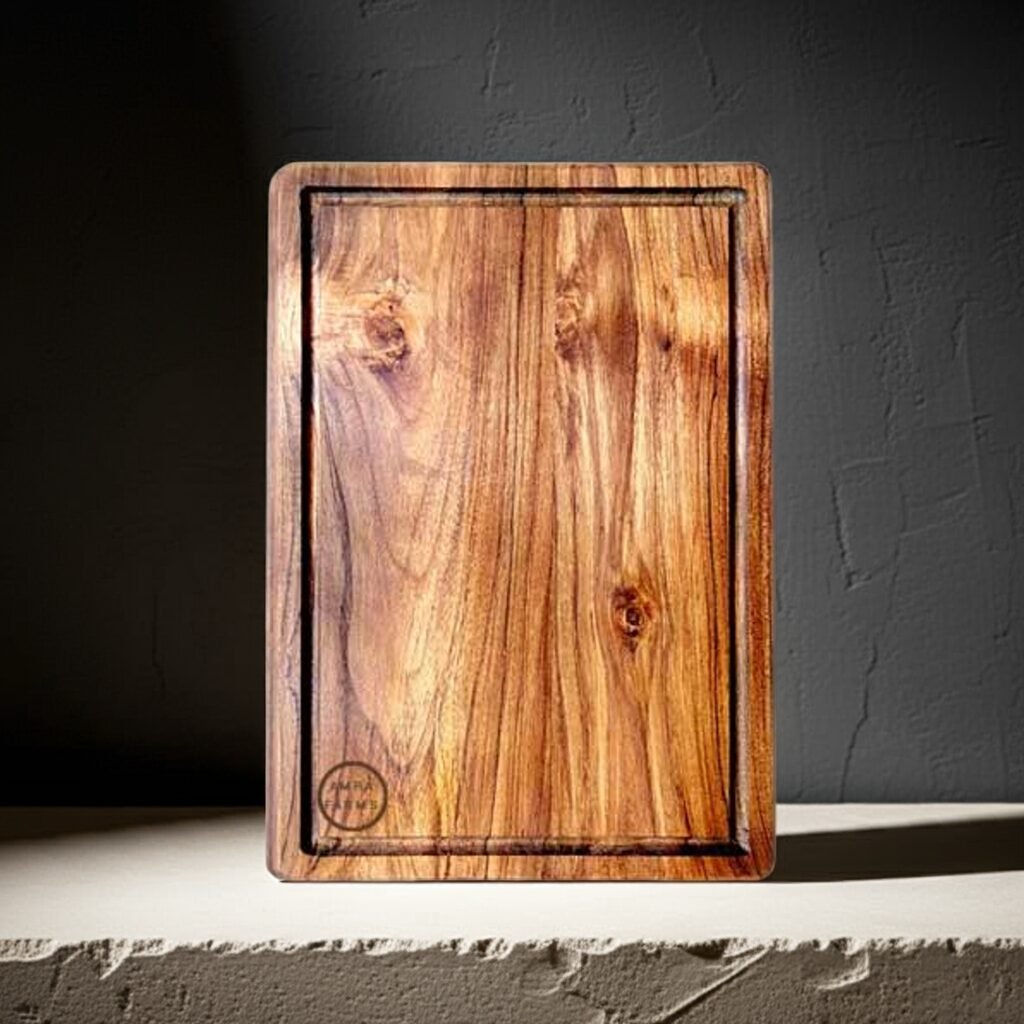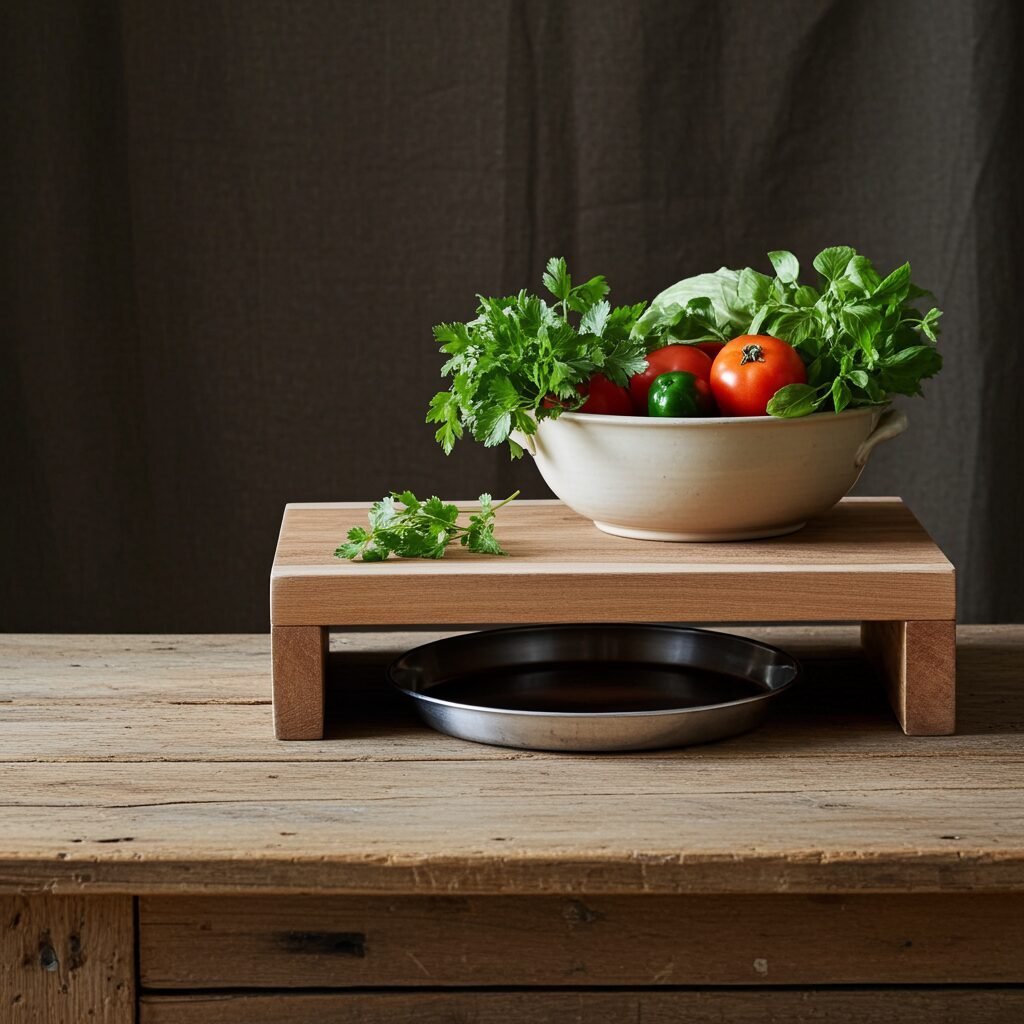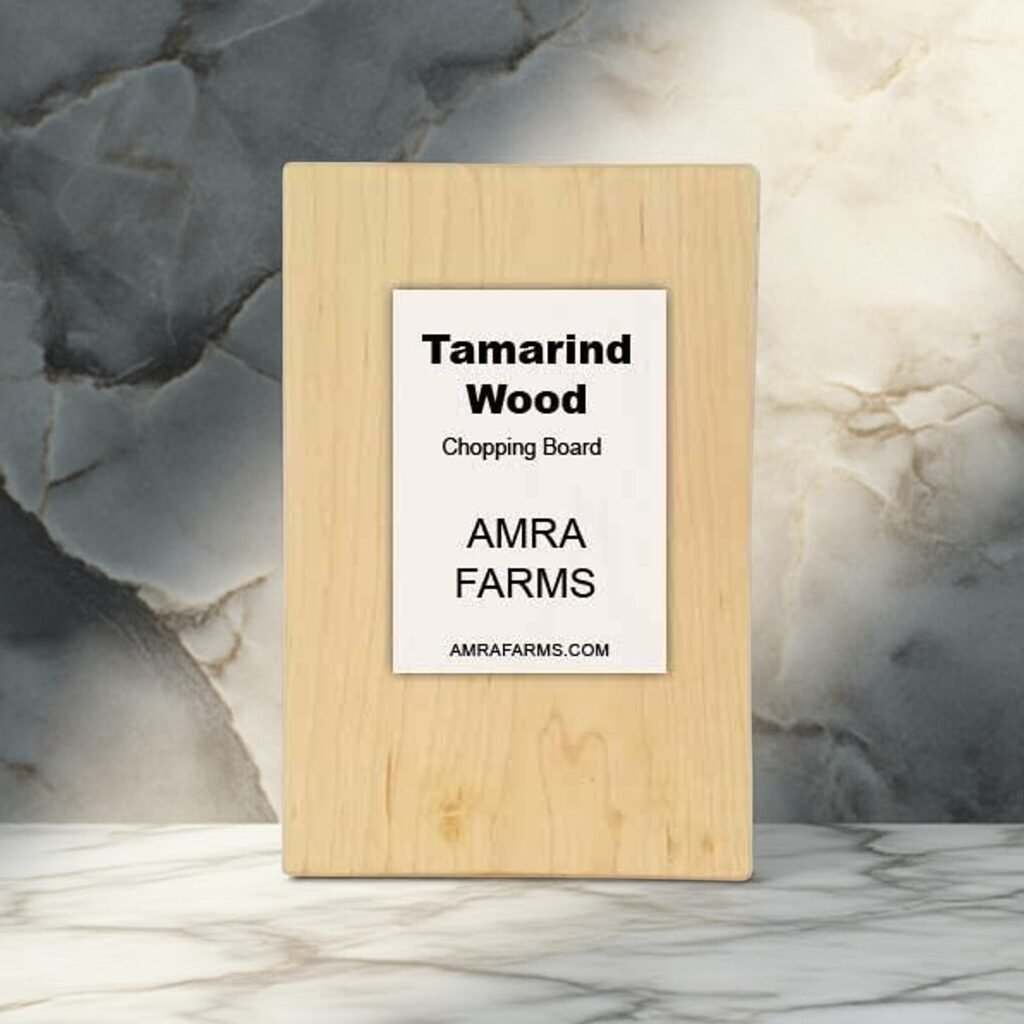Your cart is currently empty!
Are Wooden Chopping Boards Hygienic?
When it comes to kitchen hygiene, one of the most debated topics is the use of wooden chopping boards and their hygiene compared to plastic, bamboo, steel, and glass. While many consider plastic to be safe as it is non-porous, others indicate that plastic, over time, develops deep cuts and is potentially more unhygienic than wood, which has natural healing properties and is antibacterial. Wooden boards are often considered unhygienic as they are porous and tend to retain moisture from the food you cut, which over time accumulates bacteria. On the contrary, research indicates that wood is often naturally antibacterial, especially when cleaned well and maintained properly.






This article explores the science behind wooden chopping boards, compares them to other materials of chopping boards in the market today, and provides tips on how to keep them clean and hygienic.
Understanding Wooden Chopping Boards
In India, we have traditionally used wooden chopping boards for ages. Your mom and your grandma used chopping boards made of wood available locally. In the southern part of India, tamarind wood is commonly used for its hardwood features. North India used more of mango wood and other food-safe wood materials in the past. Aesthetic appeal was often not considered a priority in the past. With changing times and the unavailability of wooden chopping boards in the market, many have chosen other alternatives. However, for those who prefer traditional aesthetics, a wooden chopping board is an inevitable accessory in the kitchen.
Types of Wood Used for Chopping Boards
The choice of wood impacts your kitchen’s aesthetics but, more importantly, determines the cost, durability, hygiene, and overall performance of your chopping board. Some commonly used woods for chopping boards in India include:
Mango Wood: Easily available, a sustainable choice of hardwood. When mature, mango wood can be dense, durable, and hygienic. When compared to other premium woods, mango wood is cheaper but relatively softer too. Mango wood is naturally antibacterial and self-healing, making it one of the best choices for chopping boards. Mango wood chopping boards are becoming more popular due to its sustainability and rustic beauty.
Teak: Dense and durable, expensive, and considered a pricey wood, teak is naturally antibacterial and self-healing. The natural oil in teak helps with antibacterial properties, making it suitable for a chopping board. Teak is hard to cut but soft on knives. Though teak is one of the most preferred woods for chopping boards, its cost limits people from purchasing teak chopping boards.
Bamboo: Bamboo, technically not wood but a grass, is a durable, sustainable product that is easily available. Being the second-largest producer of bamboo in the world, bamboo is cheap and readily available. When it comes to chopping boards, they are easy to make, sustainable, and in many ways similar to wood in their properties, including hygiene and food safety.
Sheesham: Sheesham falls between mango and teak in terms of durability and price. Known for its beautiful grains and dark color, sheesham is relatively softer than teak but stronger and harder than mango wood. Sheesham is sturdy and resists cracking and warping. It is also known for its non-toxic features.
Acacia: Acacia is naturally antibacterial and a durable wood that is perfect for chopping boards. Comparatively less priced than teak but on the higher scale compared to mango wood, acacia is a durable option for chopping boards. It is hygienic and safe.
Tamarind: Tamarind wood is dense and durable. Naturally antibacterial, tamarind wood has a yellowish color with light grains. Though not appealing compared to other woods in terms of looks, its durability is much higher than most other woods. A popular choice for butchers in the southern part of India, tamarind wood is known to handle cuts graciously and has a very high lifespan. Tamarind is a safe chopping board material for raw meat. Tamarind wood chopping boards are more preferered and used in Southern part of india
Neem: Not the best choice for chopping boards, neem is strong but has the tendency to crack if left in the sun or not cared for properly. It is very hygienic and safe to use as a chopping board. Naturally antibacterial, neem is known for its medicinal properties and is self-healing too. With proper care, though, neem is one of the safest woods in terms of hygiene.
How Wooden Boards Differ from Plastic, Glass, or Steel Boards
Plastic vs. Wooden Chopping Boards: Plastic is non-porous and easy to clean, but with regular use, plastic tends to develop deep cuts and grooves, harboring bacteria. Also, the possibility of microplastics is high.
Glass vs. Wooden Chopping Boards: Glass is non-porous, easy to sanitize, and excels in every way compared to wood when it comes to sanitization. They are dishwasher safe and have a long lifespan. The downside to glass chopping boards is that they are heavy and can easily crack if dropped.
Steel vs. Wooden Chopping Boards: If you are a professional chef, you would know that a steel chopping board is tough on your knives. While they are easy to clean and sanitize, apart from being dishwasher safe, they dull your knives faster than most other materials. They last a long time but develop scratches on the surface. When compared to wood, though, steel is one of the best options in terms of hygiene.
The Science Behind Wooden Chopping Boards
One of the biggest concerns about wooden chopping boards is hygiene. Wooden boards are porous and have been feared to trap moisture, resulting in fungal and bacterial growth in wood. Surprisingly, the antibacterial properties in wood are strong enough to kill bacteria over time. Hardwood cutting boards are also self-healing. Unlike plastic, which is stable but can harbor bacteria over time with constant use, wooden chopping boards are self-healing, antibacterial, and safer. BPA-free chopping boards are also sought after, making wood the preferred choice.
Wood has natural antibacterial properties. The oil in wood differs from each material. For instance, acacia is antibacterial with the ability to prevent Salmonella, E. coli, and Staphylococcus. (Ref: https://pmc.ncbi.nlm.nih.gov)
Wood contains chemicals like tannins, which are antibacterial and antifungal. Mango wood and tamarind are naturally resistant to fungal and bacterial growth. The high oil content in teak prevents the growth of fungus and moisture retention, making it a preferred choice for chopping boards. No matter how good your wood is, cross-contamination prevention is important. Foodborne bacteria on kitchen surfaces can always be a problem. Cleaning your cutting boards regularly and following best practices for disinfecting chopping boards should be ensured every few days.
Common Hygiene Concerns with Wooden Chopping Boards
One of the major concerns about wooden chopping boards is their moisture retention. Wood is porous. If you compare porous vs. non-porous cutting surfaces, wood may seem to have a disadvantage. On the contrary, the moisture content in the wood helps in its binding properties, making it more durable over time. Lesser moisture and oil content in wood make it brittle and prone to cracking. Also, the natural antibacterial properties of wood make it safe, even with its porous nature, provided they are disinfected regularly and sanitized occasionally. Wood absorbs bacteria along with moisture, but instead of allowing the bacteria to thrive, they are trapped and prevented from multiplying. With proper drying in a well-ventilated area, wooden chopping boards prove to be a safe option. When it comes to cross-contamination, use separate boards or clean your chopping boards regularly. Sanitize with a diluted hydrogen peroxide solution or vinegar—both of these options are great for disinfecting wooden chopping boards without damaging the wood. Always wash wooden chopping boards after every use and immediately after cutting meat and switching food types.
Cracks and Knife Marks: Do They Make Wooden Boards Less Hygienic?
Cracks are not good, but knife marks are okay. If you have large dents in your chopping board after constant use for a year or more, we recommend that you change the chopping board. If there is a crack, it’s recommended that you replace your chopping board immediately. Cracks will harbor bacteria, and in most cases, there is nothing that can be done with the chopping boards. You could use your chopping board as a tray or for craft projects if cracked, with little modifications at home. As for chopping boards with knife marks alone, you could either sand the surface with sandpaper and use it again.
How to Keep Wooden Chopping Boards Hygienic
Chopping board maintenance and cleaning is a regular process that ensures your chopping boards remain safe for use for a longer period of time. It also increases the lifespan of your chopping boards. These few tips should help you maintain the chopping board and ensure it is safe for a longer period of time.
- Washing: Rinse the board with warm water immediately after use. This removes food particles and keeps your chopping board clean. Use mild soap and scrub with a soft brush to remove lodged particles. Avoid using hot water on your boards and use a soft brush to clean the surface. Do not use wires. Avoid soaking your chopping boards, as this will result in warping and later cracking.
- Disinfecting: While disinfecting, use food-safe chemicals that are not harmful to you or the wood. Natural solutions like vinegar can be sprayed to kill bacteria naturally. You can also spread salt and scrub with lemon to remove light stains on the surface while keeping it clean. After cutting meat, spray your board with a 3% hydrogen peroxide solution and rinse after a minute.
- Drying: Always keep your chopping board dry when not in use. Pat dry with a clean towel immediately after washing. Do not sun dry your board. Keep the boards upright or place them in a drying rack to allow air circulation. Do not keep the boards flat on a surface that will trap moisture and prevent drying on the bottom.
Maintenance of Wooden Chopping Boards
- Oiling: Apply food-grade mineral oil, beeswax, or any dense cooking oil to the surface every week to prevent the wood from drying out and cracking. Do not use oil with a strong odor. We prefer coconut oil, but a wide range of cooking oils can be used as long as they do not leave color or smell on the board. Avoid mustard oil due to its strong flavor and sesame oil as it is too thin.
- Sanding: You can use sandpaper once every few weeks to bring your board back to its original state. Use 80-120 grit sandpaper for a smooth finish. Rinse and dry before you oil the surface. This simple process ensures your boards look like new even after years of use.
- Avoid prolonged soaking: Wooden chopping boards are not dishwasher-safe, and prolonged soaking will weaken the wood, causing splitting. Do not ever soak your wooden chopping boards. No matter the material, your chopping boards will warp and crack in a short span of time.
Tips to Prevent Contamination
- Use separate boards: While not always practical for homes, you can try to use 2 or 3 different boards—one for meat, one for fish, and one for vegetables. Using separate boards is the easiest way to avoid contamination, though it can be expensive. Alternatively, ensure that you clean your wooden chopping boards thoroughly before switching food types, especially after cutting meat and fish.
- Clean immediately after use: Do not let your chopping boards sit with residue for long. The moisture in the food, whether vegetables or meat, will seep in. Clean the boards immediately after use.
- Store in a dry place: Store your chopping boards in a well-ventilated area to prevent moisture and mold growth. Avoid areas with direct sunlight.
Categories
Products
- Buy Wooden Vegetable Cutting Boards Online
- Wooden Kitchen Accessories Tools
- Buy Butcher Block & Meat Cutting Boards Online
- Buy Premium Edge Grain Single Block Wooden Chopping Boards Online
- Buy The Best Teak Wood Chopping Boards Online In India
- Buy Wooden Cutting Boards With Handle For Kitchen
- Mango Wood Chopping Boards
- Single Block Chopping Boards
- Tamarind Wood Chopping Boards
- Wooden Platter Boards , Pizza Platters & Charcuterie Boards
Tamarind Wood Cutting Board Teak Wood Cutting board
Recent Posts
- Unique Wooden Chopping Boards with Medicinal Benefits
- Exotic Woods of India and Its Uses
- Best Uses of Teak Wood: Common and Unique Applications That Make It the King of Hardwoods
- What to look for when purchasing a teak wood cutting board and how to identify teak wood
- Wooden chopping boards that naturally resist fungus/mould growth
